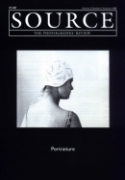Irelantis
'Irelantis' by Sean Hillen was at Clotworthy House, Antrim, 1996
Review by Catherine Duncan
Issue 9 Autumn 1996
View Contents ▸
Ever seen the Great Pyramids of Carlingford? Their corn-coloured geometric forms compliment the seemingly half reared nature in which they are planted: their staid elegance points to a new horizon. A jolly red jumpered Irishman contemplates the scene with satisfaction. His vantage point is ours, the planetary horizon stretches out before him, and he is master of all he surveys.
Pyramids? ...in Carlingford? Well a mystical invocation of imagination anyhow, and something kind of plausible too. It's not strictly Ireland, it's Irelantis, a land created by montage artist Sean Hillen. Its Fantasy Football crossed with the history of the world, and its pitch is a Irish postcard. Hillen captains a starship Irelantis floating through the Cosmos, through time and space that condenses civilisations and religious beliefs in a vehicle that reaches beyond kitsch. The chimerical visions move backwards and forwards in time from what might have been to what might be: the Stone Age, the New Age and the Virgin Mary rub shoulders in Temple Bar, in a holy picture befitting a contemporary Dublin; in another, glass skyscrapers and a Greco-Roman oracle sandwich O'Connell Street. The Great Pyramids of Carlingford Lough - Collage 1994
The Great Pyramids of Carlingford Lough - Collage 1994
I saw this exhibition at Clotworthy House, Antrim in August, and spoke to Hillen about his work past and present. The Irelantis series has been created over the past two or three years since the artist returned to Ireland after some time in London, where he attended the Slade College of Art, after his degree at the London College of Printing. He hails from Newry, but is now working in Dublin.
The works are carefully crafted from found imagery. This means the ingredients for the fantasy are reality, and become a particular version of it. John Hinde is credited for part of this vision, his stylised picture postcard Ireland featuring in or influencing the works. When I talked to Sean Hillen, he referred to a philosophy of perception called a 'reality tunnel', concerning identity and comprehension, positing a theory that we are all separated by the gap between language and empathy, and true reality. We all remain in our separate worlds. This means that even when we presume that we are on the same wavelength as someone else, we can never truly understand how they see things: we are all in separate 'tunnels'. Language and communication are common codes, but there are gaps, mutations and nuances in all these. In our insurmountable separation from each other as individuals , there is also a search for a common identity, and Hillen was happy with Seamus Heaney's surmisal that there was 'anxiety' in the works that asked 'Who are we?' This suggests that place and identity are linked, but Hillen asks whether it is we who take our identity from our place, is it really vice versa, or a two way street. He points out that reality is subjective, and that being so, that 'no one is wrong'. Horse Racing near The Ruins of Stephen's Green - Collage 1995
Horse Racing near The Ruins of Stephen's Green - Collage 1995
Hillen is also interested in our hypnosis by words and naming and the strength of attraction we have to their supposed meaning and the identity we can imagine for ourselves through labels or terminology. It is difficult to imagine something we cannot put into words, and naming encourages us to accept for example, a state, concept, object or place as true or existent. All Hillen's works in the Irelantis series are carefully named with ridiculous titles that give authenticity to the images to which they relate. The titling of the works is important to provide definition, providing a full stop so that the viewer realises the sentence is finished, so they must study again the apparently incongruous group of phrases. These long titles owe something to predecessors such as Joseph Beuys, or Duchamp, whom Hillen refers to in affinity: he too wishes, at least in part, 'to amuse himself primarily and trust the rest to posterity'. Although he has made political work that has been construed as propaganda and subsequently stifled from public view, these works are made in a benign artistic spirit, a desire to make beautiful and healing works. Some warn of the transience of 'our' world, that nature or chaos could strike disastrously at any time. Whilst the work has a knowing and contemporary side, it simultaneously has a very idiosyncratic, craftsmanlike quality. Hillen has access to technology, but still prefers the human touch when it comes to cutting and pasting.
'The Queen of Heaven appears at Newgrange' epitomises a condensation of religious belief in Ireland since time immemorial to the present. A mix of Irish magics, both naive and all knowing, from the earliest tribal use of the sun, to the use of laser printing: a reverent awe of a structure older than the pyramids or a half baked invocation of Mystic Meg: the most famous single mother from the Middle East as a barely but instantly recognisable stylised totem. These images are used and abused everyday, whether they are grasped defiantly or appropriated into tourist publicity. Hillen allows these images to get their own back. Here is the push and pull of the history and the future. Here is the humour, and the truth contained therein.
Other articles by Catherine Duncan:
Other articles mentioning Sean Hillen:
Other articles mentioning John Hinde:
Other articles mentioning Joseph Beuys:
Other articles mentioning Marcel Duchamp:
Other articles on photography from the 'Photomontage' category ▸






